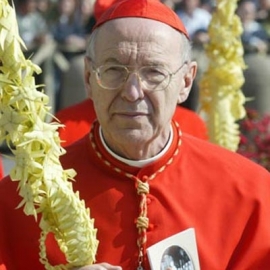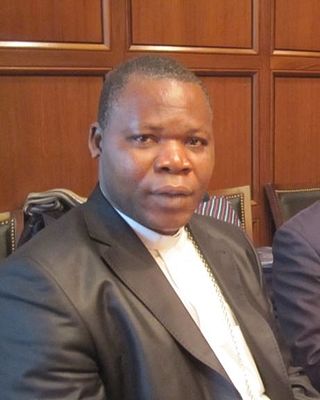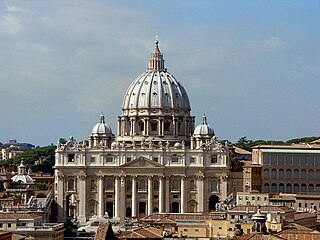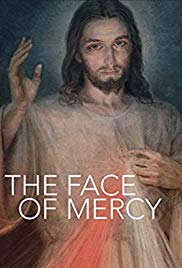A jubilee is a special year of remission of sins, debts and universal pardon. In Leviticus, a jubilee year is mentioned to occur every 50th year; during which slaves and prisoners would be freed, debts would be forgiven and the mercies of God would be particularly manifest.

The Society of Saint Pius X is a canonically irregular traditionalist Catholic fraternity of priests founded in 1970 by Archbishop Marcel Lefebvre. Lefebvre was a leading traditionalist at the Second Vatican Council with the Coetus Internationalis Patrum and Superior General of the Holy Ghost Fathers until 1968. The society was initially established as a pious union of the Catholic Church with the permission of François Charrière, the Bishop of Lausanne, Geneva and Fribourg in Switzerland.

Mercy is benevolence, forgiveness, and kindness in a variety of ethical, religious, social, and legal contexts.

A Holy Door is traditionally an entrance portal located within the Papal major basilicas in Rome. The doors are normally sealed by mortar and cement from the inside so that they cannot be opened. They are ceremoniously opened during Jubilee years designated by the Pope, for pilgrims who enter through those doors may piously gain the plenary indulgences attached with the Jubilee year celebrations.

The Great Jubilee in 2000 was a major event in the Catholic Church, held from Christmas Eve 1999 to Epiphany 2001. Like other previous Jubilee years, it was a celebration of the mercy of God and forgiveness of sins. The major innovation in this Jubilee was the addition of many "particular Jubilees" for various groups of persons, and that it was simultaneously celebrated in Rome, Israel, and elsewhere in the world.

Francesco Marchisano was an Italian Cardinal who worked in the Roman Curia from 1956 until his death.

The Apostolic Penitentiary, formerly called the Supreme Tribunal of the Apostolic Penitentiary, is a dicastery of the Roman Curia and is one of the three ordinary tribunals of the Apostolic See. The Apostolic Penitentiary is chiefly a tribunal of mercy, responsible for issues relating to the forgiveness of sins in the Catholic Church.

Péter Erdő is a Hungarian cardinal of the Catholic Church who has served as the Archbishop of Esztergom-Budapest and Primate of Hungary since 2003.
The history of the Catholic Church is integral to the history of Christianity as a whole. It is also, according to church historian Mark A. Noll, the "world's oldest continuously functioning international institution." This article covers a period of just under two thousand years.
Misericordia is the Latin for "mercy", derived from misericors, "merciful", which is in turn derived from misereri, "to pity", and cor, "heart", and may refer to:
The canonical situation of the Society of Saint Pius X (SSPX), a group founded in 1970 by Archbishop Marcel Lefebvre, is unresolved. The Society of Saint Pius X has been the subject of much controversy since 1988, when Bernard Fellay, Bernard Tissier de Mallerais, Richard Williamson and Alfonso de Galarreta were illicitly consecrated at Ecône, at the International Seminary of Saint Pius X as bishops in violation of canon law. Lefebvre and the four other SSPX bishops individually incurred a disciplinary latae sententiae excommunication for the schismatic act; the excommunications of the four living SSPX bishops were remitted in 2009.

Misericordiae vultus is a papal bull of indiction issued on April 11, 2015, by Pope Francis, proclaiming an Extraordinary Jubilee of Mercy from 8 December 2015, the Feast of the Immaculate Conception, to 20 November 2016, the Feast of Christ the King.

Dieudonné Nzapalainga, CSSp is a Central African prelate of the Catholic Church who has been the Archbishop of Bangui since 2012, where he served as apostolic administrator from 2009 to 2012. He has been president of the Central African Episcopal Conference since 2013.

Angelo De Donatis is an Italian Catholic prelate. He has been Major Penitentiary since April 2024. He was Cardinal Vicar and Archpriest of the Archbasilica of St. John Lateran from 2017 to 2024.

The SecondExtraordinary General Assembly of the Synod of Bishops, was held in Vatican City from 24 November to 8 December 1985 on the topic of The Twentieth Anniversary of the Conclusion of the Second Vatican Council. The synod was a gathering of 165 bishops and other participants to celebrate, verify, and promote the council, also known as Vatican II. The participants evaluated the implementation of the changes heralded by Vatican II in the past, and discussed how best to apply them in the future. The bishops discussed topics including secularism, evangelization, the universal call to holiness, formation of seminarians, catechism, liturgy, communion, the role of the laity, ecumenism, the preferential option for the poor, and Catholic social teaching.
The World Day of the Poor is a Roman Catholic observance, celebrated on the 33rd Sunday of Ordinary Time since 2017. It was established by Pope Francis in his Apostolic Letter, Misericordia et Misera, issued on 20 November 2016 to celebrate the end of the Extraordinary Jubilee of Mercy.

Aperuit illis is an apostolic letter, by Pope Francis, issued "motu proprio" on September 30, 2019, the Feast of Saint Jerome, instituting the annual observance of the 3rd Sunday of Ordinary Time as "Sunday of the Word of God", devoted to the celebration, study and dissemination of the Word of God. The first "Sunday of the Word of God" occurred on January 26, 2020. The Pope said that he wrote the Apostolic Letter in response to requests from around the world to celebrate the Sunday of the Word of God.

The Face of Mercy is a 2016 documentary about Faustina Kowalska, her mystical visions, and the role that the Divine Mercy has played in different people's lives. It is narrated by Jim Caviezel.

The Pope Francis bibliography contains a list of works by Pope Francis.

The Jubilee of 2025 is a jubilee that will be celebrated in the year 2025. It was announced by Pope John Paul II at the end of the Great Jubilee. This jubilee was preceded by the Extraordinary Jubilee of Mercy of 2015–2016.




















